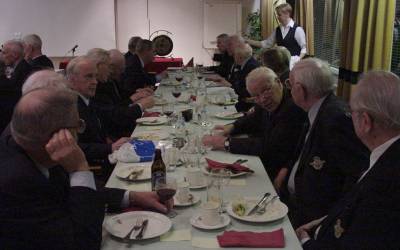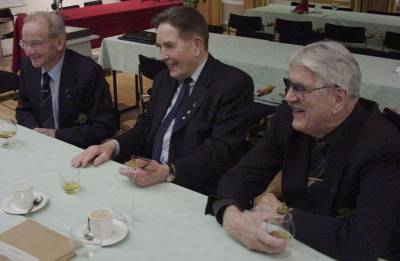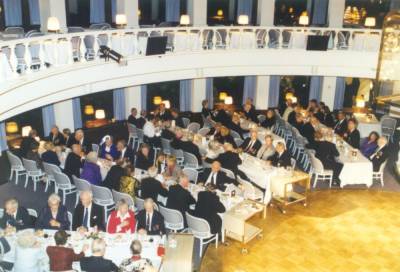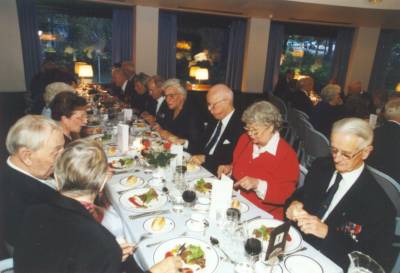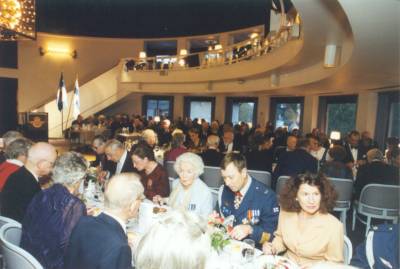
» Palaute
|
 |
Kotisivu | Sotahistoriaa | WW2History-Pilvenveikot25years.html
| |
Chaps of the clouds (Pilvenveikot) 25 years
The original article was published in the aviation magazine Siivet (Apali
Kustannus) No. 2/2002. Some interview and other material left over from
writing the article has been added to this text. The material added has not
been edited to the level of a magazine article and so the style of the text
may vary considerably.
Text: Jukka O. Kauppinen
 Twelve war pilots signed in September 1976 the founding document of the
association for the military pilots of the wars 1939-1944. The purpose of
the Pilvenveikot association is to unite the war pilots and to cherish the heritage
of a Finnish pilot. The association has fulfilled this task credibly already
for 25 years.
Twelve war pilots signed in September 1976 the founding document of the
association for the military pilots of the wars 1939-1944. The purpose of
the Pilvenveikot association is to unite the war pilots and to cherish the heritage
of a Finnish pilot. The association has fulfilled this task credibly already
for 25 years.
Anybody who had received the Finnish pilot's wings, gunner's or radio operator's
badge is able to apply for the membership of Pilvenveikot. During 1918-1944
altogether 1234 pilot's wings and 62 navigator's badges were granted and to
328 persons on the honoris clausa basis. In 1942 the gunner-radio operator's
badge was founded and 161 persons received it. Of all the above persons
516 have joined the association over the years and there are still 238 members in
the ranks. During the past years also the pilots and the navigators of the
Swedish voluntary Squadron F19 and the German flying unit Kuhlmey (Gefechtsverband Kuhlmey) have
been accepted into the brotherhood of the Finnish war pilots. There are
still two Swedish and three German Pilvenveikkos living.
| |
|
| |
The idea of the association originated from Britain
The Pilot association Pilvenveikot started around 1974 when the reconnaissance and
test pilot Kullervo Virtanen saw a Royal Air Force
uniform with a pilot's association Badge on the chest, in a London shop's window. Virtanen was pondering with
his travel companion that it would be good to have a similar aviation association in Finland as well. The war pilots were noted to be a
suitable small group and as the result of Virtanen's efforts the association was
founded in 1976. The name of the association was derived from a poem Pilvenveikko
(Fellow of the clouds) by the Finnish national poet Johan L. Runeberg. This poem
was written already in 1848 and is a part of the Stories of Ensign Ståhl by Runeberg.
Of the twelve founding members, from the "root squadron", five are still
alive and they act as the final decision board of the association for example by
deciding who will be accepted as a member. As a basic principle nobody is
invited as a member but one has to have a desire to apply for membership. Pilvenveikot has
been from the beginning an unpolitical association which first of all offers
to the war pilots a common meeting place and an equal companionship with the
aim of keeping up the good old pilot spirit.
In the association the war pilots continued their activities more united and
organized. The pilots have of course been in touch with each other also
before. The chairman of Pilvenveikot Olli Kivioja tells: "earlier there was
a kind of association in Helsinki formed by pilot veterans who flew
actively in a forward airbase called Tiiksjärvi. They kept close contact by
meeting each other and organizing for example skiing trips. I have heard
that there have been similar groups also elsewhere which had become friends
and held joint meetings".
"Among others the Kauhava pilot training courses each formed their own
groups. When the courses were completed men were assigned to the squadrons
and to the flights. Then in the same squadron and in the same flight could
be pilots from several training courses and in that way the group was more
homogenized. They were united by the work environment but others were united
by the same Kauhava training period". Many Kauhava courses have kept close
contact over the years. Of the squadrons for example the Bomber Squadron 42
gathers each year.
| |
|
| |
Monthly meeting of the pilots
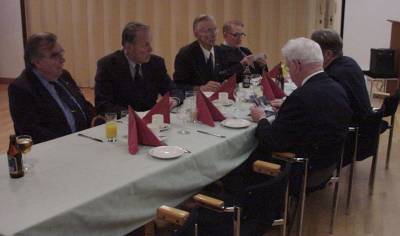
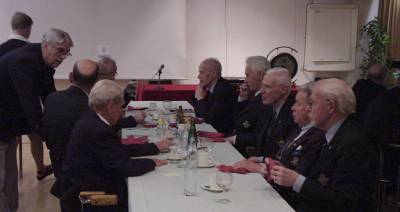
|
The main activity of the Pilvenveikot is to gather to a monthly association
meeting in Helsinki. Dozens of members are regularly participating in the
meetings. Mr. Kivioja is stressing the meaning of these gatherings: "at this
age it is a good opportunity to meet friends."
At the association meetings the aim is also to keep in touch with what is going
on by listening to presentations about various subjects of history, present
day and future. The lecturers have been from the aviation circles and
from other fields as well and according to the previous chairman Kauko Aho
"nobody has refused to give a presentation when asked. All have seen it to
be a matter of honour." Often there are also visitors in the association evenings,
for example in December (2001) there were "the Aviation Attache of the Embassy of
the USA together with the Lady Ambassador's husband, who is a veteran of the
US Navy and his seventeen years old son. Just on the previous day they
called that still one girl would like to come. It appeared that "the girl" was
mother of the Ambassador and was in the same age group with the veterans,
a very lively American Ma'am. She gave a small presentation and strolled
around the tables greeting almost everybody." The principles of the association are
also to honour the Day of the Air Force and the Memorial Day as well as a
particular ritual at the funeral of the aviator comrades. As the other
veterans have done the Pilvenveikot have also given presentations as
private persons for example in schools and in the meetings of other aviation
groups eg. in the so called Ilmasilta (Air Bridge) associations. "Many have been eager
to do youth work in various aviation associations" Kivioja tells.
Pilvenveikot have made as well various trips to other countries such as
in May 2000 a bus trip to Latvia and Lithuania to meet local aviation
friends. The association has been very valuable source of information and
inspiration even to younger aviators and the members have appeared also in
the television telling about aviation.
| |
|
| |
Pilvenveikot are a disappearing resource
Over the years the average age of the members has however grown and even the
youngest (during 2001) are at least 76, the eldest already 93. During the past ten years it has been discussed
whether the association is only for the flyers of the
last wars or should younger members be taken along, so that the activities
would continue in the future. As a result of the discussions it has however
been decided that "the association is a association of the war pilots and that's it. If
the future generations want to continue the heritage of the Pilvenveikot
it is their matter."
The continuation of the Pilvenveikot's traditions will be in the long run
on the shoulders of the heritage and aviation associations, like the
association of retired Air Force pilots "Ikikotkat", "Eternal Eagles" and the local
Air Bridge associations. Pilvenveikot and Eternal Eagles have one major
difference though. Finnish Air Force was before and after the war two
different things. Before the war the trained pilots went to reserve, that is during
1920's and 1930's. When the war started the majority of the pilots and
navigators were therefore reserve officers and only few were career officers from the Cadet
School. After the war and nowadays all Air Force officer pilots go through
the Cadet School (Military Academy). So the most of the Pilvenveikot
have a civilian profession and the Eternal Eagles are retired from the Air
Force posts.
| |
|
| |
25th Anniversary at Fisherman's Cottage
 The association founded in 1976 turned 25 years in 2001. The Pilvenveikot
gathered on the 9th September to the restaurant Kalastajantorppa (Fisherman's Cottage) in
Helsinki. Eighty-three members came to the celebration including one Swedish
and two German Pilvenveikot members. Many were accompanied with their wives so
altogether 166 people had a joyful evening remembering the war time and
discussing the happenings of the present.
The association founded in 1976 turned 25 years in 2001. The Pilvenveikot
gathered on the 9th September to the restaurant Kalastajantorppa (Fisherman's Cottage) in
Helsinki. Eighty-three members came to the celebration including one Swedish
and two German Pilvenveikot members. Many were accompanied with their wives so
altogether 166 people had a joyful evening remembering the war time and
discussing the happenings of the present.
During the evening speeches gratitude was shown to the foreign pilots
fighting in the Finnish wars. The chairman Kivioja directed his words to the
pilots of the Swedish Squadron F19 present in the evening. In the same
manner it was noted that Finland and Germany were fighting against the
common enemy during the Continuation War. Kuhlmey's support was one of the
key elements in the defencive victory during the summer 1944. The importance of the
photo reconnaissance in the 1944 defensive battles was brought out as well.
The Swedish Pilvenveikot member Thure Hansson was recalling the Winter War times
and presented the Emblem of the Swedish Air Force to the Pilvenveikot
on behalf of the commander of the Swedish Air Force major general Mats Nilsson. The German colonel
Wilhelm Goebel on his part presented the Emblem of the German brother
association. Quoting the speech of Frans-Josef Schoppe who flew in the
Kuhlmey's group:
"It is a rather wonderful feeling and a great honour, as the former leader
of a Kuhlmey's fighter-bomber Flight in the decisive 1944 battles of the
Carelian Isthmus, to stand here together with - one of the best - flight
comrades and to see those brothers in arms, to whom I have
become attached irreversibly since that summer, in front of me.
| |
|
| |
International friendship
Over the years Pilvenveikot have made international contacts and visited abroad
in different occasions. Especially they have had active contacts
with the Swedish voluntary squadron F19 and it's heritage squadron F21. In
memory of the war time cooperation they organize an annual meeting in turn in
Luleå, Sweden and in Rovaniemi, Finnish Lapland. Then meet also present
pilots of the F21 and the meetings are described to be warm hearted and full
of spirit of the brothers in arms.
The meetings with the Germans have started only during the last few years
except the earlier visits of the Kuhlmey's folks in Finland. Now meetings of
the military fliers have been organized in Germany and in the autumn 2001
the Finns Väinö Pokela, Kyösti Karhila and Heikki Nikunen were present.
Their presence and especially their medals of honour attracted considerable
attention.
In Kivioja's words:
"In the Kuhlmey's Group was this Schoppe, who gave also a
speech in the party. He has visited Finland every now and then. With the
Swedes we have had meetings, they have their heritage squadron F21 in Luleå.
It is the heritage squadron of the F19. Almost every year we have a common
occasion, in turn in Rovaniemi and in Luleå. We have met present fliers of
the F21 and there have been also those Swedes who were in the Winter War".
"Together with the Germans these meetings have started during the last
couple of years. The Germans organize once a year in September a meeting of
the fliers of the last war in which also the Allied fliers participate. The
Finns have had a representation last time by Pokela, Karhila and Heikki
Nikunen. Schoppe has visited Finland, Kuhlmey has also but he has passed
away. Dödel is younger and was not a war time flier".
During the common activity it has been noted that the spirit and thoughts of
the German war fliers are very much the same as with the Finns: togetherness
trust with each other and patriotism have sped up their as well as Finnish
Pilvenveikot's steps.
Kivioja tells about the meetings with the Swedes:
"I have been only three times in Rovaniemi and always something prevented me
going to Luleå. But I have heard that it has always been a very warmhearted
and friendly occasion. I spoke in telephone with the present commander of
the Luleå Air Base and he is very friendly and positive towards us. Frank
Fredricsson is that present colonel".
"In Rovaniemi we have had normally a two days program and spent one night
there. We have acquainted ourselves with the present squadron. Then we go
to North along the Sodankylä road about 10 kilometers. On the right or East
side of the road comes a small lake and there a household school. There a
memorial statue, a stone, was erected a few years ago with ceremonies and
during the following years were have placed a wreath besides it. And then we
had a dinner at the officer club and a common meeting."
"In one of the occasions one of the Swedish veterans died there. He was this
Arne Jung. He came to Finland together with the F19 and on the first sortie
two Swedish planes collided. He became a prisoner of war and was then on the
monastery island in the White Sea in a prison camp until he was transferred
to Leningrad. There he was threatened that tomorrow he will be executed and
thus pressed to sign a collaboration agreement with the KGB. When the Winter
War ended he received espionage training and was sent to Sweden in May 1940
But he went directly to the Swedish secret police to report and they knew
what it was all about. He said also that after that his doings were followed
all his life by both the KGB and the Swedish secret police. He served as a major in
the Swedish Air Force but when he came to Finland he said that this is the
only place where he feels at home. So this being a prisoner of war really
spoiled his life. He has made even a video program of it".
"Well, he was on this visit to Rovaniemi and left from the table around
eleven o'clock saying that he was not feeling well. We had two doctors there
and they asked me to go to his room in the morning where I found him laying
on the floor but still alive but almost dead. He was taken to the central
hospital in Rovaniemi where he then passed away. Probably it was a sudden
heart attack. In Finland he thus died in the end. So his stay in Finland wasn't very long, this time."
| |
|
| |
Of the chairmen of the Pilvenveikot
The present (2002) chairman of the Pilvenveikot is doctor Olli Kivioja
from Helsinki.
I interviewed also the previous chairman of the Pilvenveikot professor
Kauko Aho, who tells about his time as the chairman and his membership in the
Pilvenveikot.
Before Aho in the Pilvenveikot were six chairmen.
"It took a long time before I joined the association. It was founded in 1976. I
joined only 1988. It was so that I was here in Tampere already in 1979 but
the association has been all the time an association for the fliers from Helsinki. Some
have visited from Tampere but only one or two from other regions outside
Helsinki have been in the association meetings. Our pilot officer course UKK 13 had
meetings in Kouvola or Lahti regions. One fellow was reading this association
founding document and we all were dreaming about it. We were more country
boys and although our course was by far the biggest we had only a couple of
us in the association. But after ten years, when the association had found its path, I also
got enthusiast. I had visited already a couple of times and finally I joined
it.
"It made an impression to me when the then secretary Mauno Beckman wrote a
letter in which was very well written the spirit of the Pilvenveikot:
'Dear Pilvenveikko,
Welcome to our group to enjoy the company of the old pilot fellows, to
cherish that good old pilot spirit which still lives among us as the
original one. It is enough for us that the old flyer brothers feel
interested to meet each other and for this we can gather together once a
month, to exchange opinions of the old, present and new things, make
suggestions to push forward the good matters. To feel to be one of a strong
group of friends which is still enlivened by the birdmens' spirit, to enjoy
one shelf without force, to be just himself and to give something from
one shelf to the others, that is whole philosophy of being together.
On your own part you can give your effort to our activity, to come with an
open mind to the old circle of the fellow flyers. Make suggestions to enrich
our activities if you feel they are good and before all if you feel
yourself as one of the Pilvenveikot.
"In the beginning only the pilots who had flown war sorties could be members. It
was the first rule as who could join. Then the navigators who were not
pilots were taken along. And then the gunners, after a year or two. Then
they made such a change that those fliers who got their wings during
summer/autumn -44 but didn't make it to fly during the war. The present
chairman Olli Kivioja is also from that fifth course. He has flown Blenheim,
was already ordered to the war in Lapland against the Germans but the war
ended, for his luck, mishap or annoyance or what ever."
"Now it has been discussed a lot whether the association should be changed or not
but the latest discussions have been such that the association will end when the
last Fellows of the Clouds will go. Some heritage association can exist but Pilvenveikot will then be no more."
- How long you were the chairman of the Pilvenveikot?
"Two years. It was law. When I started in 1999 I had written down my
thoughts about the beginning and gave a little speech:
Early thoughts about Pilvenveikot.
"I am glad you selected me as your chairman for the next two year period. It
gives me though many problems and difficulties.
Already as a little boy I have read many times admiring and with emotion
about Runeberg's Pilvenveikot. In the Stories of Ensign Ståhl is a poem
Pilvenveikko in Swedish and I wrote it down as two Finnish translations.
Two years ago I was writing these late into night trying to catch the spirit
of it. It was some typing and sorting to get into the poem's spirit. This
chap was no Pilvenveikko in our sense since his war was fought in the
19th century. It was called the War of Finland. He was tough, this hero of
the poem."
Happenings on the Pilvenveikot's path:
- It was an idea to mention the round anniversaries of the heroes. Somebody
then said that maybe we should not. If the birthday is known they must start arranging big birthday
parties to so many of us. It was meant to be only a notification and an
opportunity to congratulate these heroes. We nearly had an argument about it.
This was ended by a request but I see that the birthdays are being mentioned
again.
- The root squadron decides about new members as was the case with this
German Schoppe. The chairman Aho called one evening to the root squadron and
asked what we should do with Schoppe, as there was a difference in opinion
about his membership in the meeting. As the root squadron was not in the
meeting they wondered that it should be very clear and an honour that we get
to the association such a hero, who has kills on his credit and operated both in the
Carelian Isthmus and in Lapland. Thus I was in contact with the root
squadron and they were very eager to get him aboard.
About the duties of the root (base) squadron
The root squadron gathers by the invitation of the chairman usually twice a
year. The chairman on his part has to plan the activities and the root
squadron has the basic responsibility for the steering of the association. The
program and the speakers are presented to the root squadron twice a year and they approve
the plan if it's good. The chairman's duty is to plan and organize the
programs of the association evenings, especially to get the speaker. He acts also
as the chairman of the association evenings and the meetings of the root squadron
as well as presents the Pilvenveikot when needed. It has been a
tradition that in the last association evening of the year there is a lottery from
which the money goes to Kauniala war invalid fellowship. Last year the money
was saved for our 25th anniversary party instead of Kauniala. As a beautiful
detail a former pupil of professor Aho, Mr.Jorma Vaajoki the chairman
of Metsä-Serla paper company granted money to organize the Pilvenveikot's
25th anniversary party.
Every time in the association evening there is a presentation. All planned subjects
have not been presented but many have.
"In the presentations it has been told eg. about breaking the sound barrier
and of all sorts. Good and also presentations a bit besides the subject.
Nobody has refused to come as a speaker when asked. All have felt it to be a
matter of honour. There have been presentations from all sides from the
bygones to the future. One of youngest has been general Heikki Nikunen, a
former CO of the Finnish Air Force. I used to write to the speakers and tell
what it is all about. It was also needed because the outsiders didn't always
know about our doings."
| |
|
| |
The speech of Professor Aho at the end of his chairmanship of the Pilvenveikot
"My job as the chairman of the Pilvenveikot is about to end. All what is
left is to pass on the information and the duties to the next chairman. I
felt it as a great honour and still do to have been selected to chair the
activities of the fellowship of the Pilvenveikot. I didn't guess it
would take up so much effort and time so it has been very wise in the
beginning to limit the chairmanship term to two years. To my knowledge the
rule has been followed. No one has felt the duties of the chairman so sweet
as to have continued over that period."
"The job has been very interesting and rewarding. I have met the fellows
from my youth and from the same Blenheim. I have been able to recognize in
you the same basic characteristic which I did already 60 years ago. Though
the years have somewhat softened our character. My duties in my life have
always been some kind of projects. Generally, though, before one ends the
other starts. I have kind of moved from one job and location to another and
now this town of Tampere is the latest project."
"As members Pilvenveikot you know that determination is a feature that helps you
out of tight spots. As members of Pilvenveikot you know as well that in some
situations it may be fatal. Who presented this thought has not been a solder
but a manager in forestry. It is a characteristic also of a pilot and what I
hear it can be fatal too."
"The word Pilvenveikko has originally meant solder. Several squadron
mates have been in the association evenings and especially I remember the
navigators, of which more than 50 have flown behind me.
Only Unto Kallio and Aarne Ellilä who have flown on common combat sorties
are left in the Pilvenveikot. With Juhani Eskola I have never flown
although we are of same age and studied together machine building. Juhani's
father Armas Eskola I remember often from the time after the Winter War in
the Luonetjärvi base, where he was the commander of the Bomber Squadron 42.
He instructed us personally, that is the CO himself taught us wireless
operation. As he was a hundred per cent wireless communications man and we
didn't learn much anything in the Kauhava course he thought that those guys
know nothing, got mad and came to instruct us himself. I felt that he
treated me like I was his own son. Once he said to me when I dared to request a
badly reasoned home leave that the times are bad, which I really
understood without saying."
"In the Summer -40 we had to stay idle on the beach of Luonetjärvi lake with
full flight gear on. We were not allowed to take them off and not to go
anywhere. About a week we were laying there and nobody told us why we did
that. We thought that we had done something naughty but we had done nothing,
it was just so tense time and we were expecting to go to a counterattack.
But our superiors, who knew, didn't tell us."
"Especially pleasant in this job it has been to be able to get acquainted
both with the present and the future commanding persons of the Air Force. I
have noted that they are well trained, very pleasant and officers who
greatly value us Pilvenveikot members. I have the feeling that the former stupid
spirit of "bossing" does not exist anymore, at least in the Air Force."
| |
|
| |
The German Pilvenveikot member Schoppe's letter to the Finns
Schoppe was supposed to come to the Utti Air Base were a memorial for the
Air Force personnel who died in the war was unveiled. It has all the names
and the dates. Schoppe could not come but he sent a letter:
"7.9.2000
Schoppe tells to have read many times the book Double Fighter
Knight by Juutilainen which he got in the previous Summer when he visited
Finland. Based on Juutilainen's and his own experiences as the pilot of JU 87
Stuka and Focke Wulf during the war in Finland he wants to present the
following in the occasion of revealing the eagle statue:
"He who has once belonged to the brothers in arms of Germany or Finland,
whether he was a member of the flight crew or of the ground personnel
who with their work and diligence created good conditions for the fight
capability of the units, knows that the spirit particular to this branch of
armed forces unites and obliges both sides of the forces. The technical
advances demand from the individuals and from the units perception and
tactical adaptation. To perform an attack alone or in a group, during the
day or night, to the ground or sea target requires often development and
learning of completely different new methods of operation. To know the fellows
on the sortie already in advance increase the sense of certainty and unity
in the critical moments. The sense of unity particular to this branch of armed
forces, the trust of each other also when a great contribution, even life,
was demanded was a basis for the performance and the behavior of this branch
of forces.
"The roots of power and the will of fight come for many from the patriotic
feelings. To the fallen and missed pilot fellows, for whom we now erect a
statue, I am always in debt of gratitude. At this point I would like once
more say the same thought which I clearly gave in my presentation in Vantaa,
in Finland to the brothers in arms:
"So you, when you have done all what you have to do, say: we are just humble
servants. We have done only what is our duty."
(Professor Aho: these words tell what is characteristic also for these
Germans since they have been blamed often for many things, but these were
here in Finland for this matter and they have not got much other thanks and
they have not asked either.)
"Unfortunately I am not able to participate in the ceremony of unveiling the
memorial, but I feel even more blessed by my brothers in arms. My sincere
greetings to all my former brothers in arms. H & B"
H & B"
This letter gives a picture also of the Cloud's Brothers although it is
written by a German. These thoughts are pretty much the same as our own and
they still are.
| |
|
| |
Background of the Pilvenveikot
Text: Olli Kivioja
 In September 1976 twelve war pilots signed the founding document of a association
which was named PILVENVEIKOT. It is a free - form association of the
pilots of the 1939 - 1944 wars based on the couple of years efforts of
Kullervo Virtanen. Five founding members are still living.
In September 1976 twelve war pilots signed the founding document of a association
which was named PILVENVEIKOT. It is a free - form association of the
pilots of the 1939 - 1944 wars based on the couple of years efforts of
Kullervo Virtanen. Five founding members are still living.
PILVENVEIKOT association is an unpolitical association of which purpose is
as a uniting bind to cherish the heritage of the Finnish fliers. There is no
membership fee.
The condition for the membership is to have an old military pilot's license
together with the Finnish Flight Badge, SLM, worn on the left breast pocket.
It has a nickname lätkä "flapper". Swedish count Eric von Rosen gave on 6.3
1918 to the then Finnish Aviation Forces their first airplane a two-seater
Morane Saulnier Parasol and provided it with his own lucky emblem, a blue
swastika which became the national sign of the Finnish military aircraft.
Vise-captain Akseli Gallen-Kallela, a famous Finnish painter, located that
swastika in the middle of the Finnish Flight Badge which he designed.
These swastika Flight Badges were given during 1918 - 1944 to 1234 pilots,
to 62 navigators and to 328 persons on honoris causa basis. The gunner -
radio operator Flight Badge founded in 1942 has received 161 persons.
By the pressure from the Soviet control commission the swastika was removed
from the Flight Badge and from the aircraft sign although the swastika of
the Finnish Air Force had nothing to do with the much younger Hitler's
swastika.
Each member has to buy a association Badge which is worn on top of the left breast
pocket and a bronze plate in the form of the old Flight Badge which will be
attached to the gravestone if he or his relatives have so wished.
Members to the association are not invited but each willing person applies for a
membership. The acceptance of new members requires a unanimous approval of
the founding members.
In the activity of the Pilvenveikot the members are equal, undependent
of the military rank or the civilian position. For this reason and based on
the war-time experiences and the heritage the spirit in the association has been
good all these years.
In the association were in the beginning only pilots but soon also the navigators
and gunner/wireless operators who had the old Flight Badge were accepted as
members. Then all members of the flight crew have the possibility to join.
The number of the members is all together 516 of which 277 in the Shadow
Squadron and of these 40 Post Morten-members. In the ranks are 239 of which
three eldest will turn 93 in 2002 and the youngest eleven 76 years. Two
Swedish Pilvenveikot members of the voluntary Squadron F19, which was
responsible for the Northern Finland's air defence in the Winter War and two
Germans of the Flight Group Kuhlmey from the Summer 1944 are still living.
The Pilvenveikot gather once a month to the association evening in a restaurant
In addition to the formal issues it is noted those who have moved to the
Shadow Squadron during the past month and for each of them a dark sounding
gong-gong will be played as the sign of the flight past with the present
standing silently.
After the presentation about a subject interesting to the Pilvenveikot a
common meal will be enjoyed. No one has refused to give a presentation when
asked. As a present the lecturer receives a glass bowl with the emblem of
the Pilvenveikot which has a text "Aquila non capit muscas", an "Eagle
does not chase flies" engraved.
The Pilvenveikot participate in the funeral of the fellow flier by
placing a red rose each on the coffin with the hymn of Finlandia being
played at the same time.
The Pilvenveikot keep in touch with the Swedish Squadron F21 from Luleå
which continue the tradition of the voluntary Squadron F19 which was
responsible for the Northern Finland's air defence during the Winter War and
with the German "die Vereinigung der Flieger deutscher Streitkäfte".
The Pilvenveikot participate in the honours of the Air Force anniversary
on the 6th of March and of the Air Force Memorial Day on the 7th September.
Olli Kivioja
Helsinki 26.9.2001
Pilvenveikot, chairman
| |
|
| |
Press release
25th Anniversary of the Pilvenveikot
19.9.2001 at 18.30 - 24.00 in Kalastajatorppa
Text: Olli Kivioja
The Pilvenveikot had the 25th Anniversary party of their free-form,
unpolitical association on 19.9.2001 at 18.30 - 24.00 in Kalastajatorppa
restaurant in Helsinki. 166 persons came to the party. Of the 239 living
members present were 83 among them one Swedish with his wife and two German
Pilvenveikot members. This Swede Thure Hansson had fought in the Swedish
voluntary Squadron F19 which was responsible for the Northern Finland's air
defence in the Winter War. The German Pilvenveikot Frans-Josef Schoppe
and Walter Schneller had been fighting abreast the Finns in June-July 1944
on the Carelian Isthmus in the German flight group Kuhlmey. They were
accompanied by a younger Frans Josef Mangels. In addition as our guest were
German fighter ace Leutenant Hugo Broch also from the Kuhlmey's troops with
81 air victories at the then German Eastern front and Colonel Wilhelm Goebel
representing the German brother association who served in the German Air
Force after the war.
There was in the party all the time a spontaneous, joyful spirit of
chatting, recalling the war-time happenings and telling the present news.
In his welcoming speech chairman Olli Kivioja noted that the Pilvenveikot
greatly value the contribution of the Swedish voluntary squadron which was
significant in the defence of Northern Finland in the Winter War. Similarly
he noted that during the Continuation War Finland and Germany had a common
enemy. The dive bombers of the fighting group Kuhlmey were one decisive
factor in reaching a defence victory in the Carelian Isthmus in June - July
1944. With united efforts we prevented the occupation of our country. The
Pilvenveikot give their admiration and gratitude to the fighting group
Kuhlmey.
Chairman Kivioja noted also the significance of the photoreconnaissance
flyers and the Photograph Center of the Air Force to the war. The
preparation of the enemy for the attack could be seen in the aerial
photographs taken on 29.5. and 2.6.1944 but the Army Corps responsible for
that front did not utilize them and so the attack in Valkeasaari came as
surprise.
When it is told about the decisive Ihantala battles in July 1944 it is not
asked and not answered how the artillery and the bombers knew the location
of the enemy's concentrations of artillery and tanks. The answer is: from
the aerial photographs which revealed among others more than ten rocket
firing positions. There the photos taken on2.7 and 3.7.1944 were utilized.
The enemy attack towards Lappeenranta ordered to start on 4.7.1944 at 04.00
could not move because the bombing and the artillery salvos directed on the
enemy troop, artillery and tank concentrations with the help of the photo
reconnaissance paralyzed them. This appeared decisive in the Ihantala battle
In his speech the commander of the Finnish Air Force, Lieutenant General Jouni
Pystynen mentioned among others "The Pilvenveikot is the group in which
is concentrated the mental heritage of the Air Force. These desired
characteristics are a strive to carry out a task uncompromisingly even when
the conditions and the enemy forces appeared to be superior, emphasizing of
the personal capability so that the enemy's superiority in numbers could be
efficiently compensated with own personal skills. The continuous development
of the tactics and the methods flexibly and intelligently based on the
gathered experiences and the strong spirit of unity which gave the mental
power even during great losses and setbacks were also vital.
"This heritage and these virtues have been cherished in the Air Force all
this time after the war and it is one explanation on how high level our
fighter defence capability is at the moment."
"European Air Forces are presently studying a possibility to arrange a
common fighter pilot training so that a few European training centers would
be founded. It is possible, if so politically decided, that one European
training centre would be in Finland. Otherwise in the development of the Air
force is not any dramatic features to be seen. The present excellent state
of our air defence is a result of a long- term and consistent development in
which all sectors have been built equally despite of fairly limited
recourses. The Air Force congratulates respectfully the Pilvenveikot."
Petteri Iivonen together with a Pilvenveikot member Tuomas Haapanen as the
accompanist got a tremendous applause at the end of his charming violin solo
Lieutenant General Pertti Nykänen in his humorous speech after the dinner
considered the meal worth thanking in which also others fully joined. To the
women he directed their well earned thanks which we men too seldom remember
to say aloud.
During the free word the Swedish Pilvenveikot member Thure Hansson recalled the
Winter War times when he was in the Swedish voluntary Squadron F19
responsible for the Northern Finland's air defence. He presented to the
Pilvenveikot the emblem of the Swedish Air Force on behalf of the CO
Major General Mats Nilsson.
The German Pilvenveikot member Frans-Josef Schoppe noted: "It is a rather
wonderful feeling and in the same time a great honour as the former leader
of the Kuhlmey's dive-bomber squadron which was in the decisive battles of
the Carelian Isthmus in the year 1944 to stand here together with - one of
the best - of my squadron fellows and see in front of me those brothers in
arms to whom I have irrevocably attached since that Summer.
I greet sincerely all women present here. And also my deep respect and
gratitude is directed to those of the Finnish Women Corps "Lotta" who
together with our German Red Cross sisters helped the German units to
perform their task in fighting for the Finnish independence. We who had the
luck or rather a guarding of the Lord to get from the war want to thank God
for that. It is also our duty to remember with respect those brothers in
arms and the citizens who shared with us the years of destiny and had to
sacrifice their lives for Finland's independence. We feel that they are with
us for ever. I wish for the Pilvenveikot still many successful years as
one source of the joy of life for my brothers in arms.
German Colonel Wihelm Goebel told that he served in the German Air Force
among others under General Kuhlmey. He gave to the Pilvenveikot as
present the emblem of the German brother association "Gemeinschaft der
Jagdflieger Vereinigung der Flieger deutscher Streitkräfte e. V." He himself
has been in the board of the association and he brought greetings from the
present chairman Lieutenant General Jörg Kuebart and the former chairman
Colonel Anton Weiler.
The evening ended in a dance with the tunes played by the Paappas "The Old Man" Group in which most of the present participated.
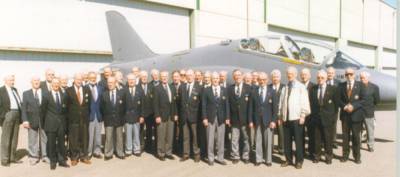
Pilvenveikot at Kuorevesi 1988
|
| |
|
Viimeksi muokattu: 2005-04-07 01:19
|
|

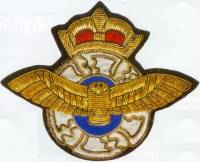
 Twelve war pilots signed in September 1976 the founding document of the
association for the military pilots of the wars 1939-1944. The purpose of
the Pilvenveikot association is to unite the war pilots and to cherish the heritage
of a Finnish pilot. The association has fulfilled this task credibly already
for 25 years.
Twelve war pilots signed in September 1976 the founding document of the
association for the military pilots of the wars 1939-1944. The purpose of
the Pilvenveikot association is to unite the war pilots and to cherish the heritage
of a Finnish pilot. The association has fulfilled this task credibly already
for 25 years.



